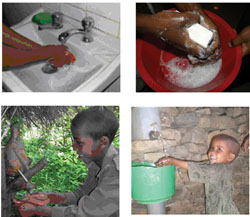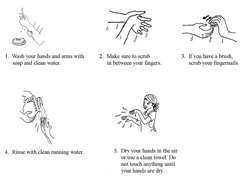3.4.3 Handwashing (hand care)
The cleanliness of our hands is very important in all our daily activities. In our normal activities our hands frequently get dirty. There are many situations in which microorganisms are likely to attach to our hands along with the dirt. There are many communicable diseases that follow the route of faeco-oral transmission. Hand hygiene plays a critically important role in preventing this transmission.
Hygienic handwashing involves the mechanical removal of microorganisms from contaminated hand surfaces using soap or detergent. Handwashing should involve more than a quick rinse under a tap (faucet) or in running water.
The following handwashing technique (also shown in Figure 3.4) ensures that the hands are properly washed and it doesn’t take long to complete:
- First wet your hands with clean water and lather with a bar of soap.
- Next rub your hands together vigorously and scrub all surfaces up to your wrists.
- Clean under your fingernails.
- Continue for 15–30 seconds or about the length of a little tune (for example, the ‘Happy Birthday’ song). It is the soap combined with the scrubbing action that helps dislodge and remove germs.
- Rinse your hands well with clean running water (pour from a jug or tap).
- Dry your hands in the air to avoid recontamination on a dirty towel – do not touch anything until your hands are dry.
- Wood ash will also rub off any dirt and smells. The slight irritation you feel when you wash your hands with ash shows the cleansing power of ash.
- Local seeds such as indod (Lemma’s plant), which are known to be good cleaning agents, can also be used for regular handwashing.
- Clean sand with water can be used for handwashing to help to rub off dirt.
If you don’t have soap, you can use alternatives. These serve the same purpose as the soap, to help ‘scrub’ what is stuck on your hands, so the running water can brush it off. To get clean hands, you must POUR the water over your hands (no dipping in a bowl!). The soap or ash ‘lifts’ the dirt, and the water then washes off the visible dirt and the invisible germs. Various options for handwashing are indicated in Figure 3.5.

As well as routine personal hygiene that applies to everyone, your daily work will include many situations when you may ask yourself when you need to wash your hands. To know when to wash your hands at home and at work, you must first identify critical situations; that is, situations, activities or incidents that indicate the possibility that pathogenic microorganisms are present on hands, fingers and nail surfaces.
Critical situations in everyday activity include:
- After using the toilet (or disposing of human or animal faeces)
- After changing a baby’s diaper (nappy) and disposing of the faeces.
- Immediately after touching raw food when preparing meals (e.g. chicken or other meat).
- Before preparing and handling cooked/ready-to-eat food.
- Before eating food or feeding children.
- After contact with contaminated surfaces (e.g. rubbish bins, cleaning cloths, food-contaminated surfaces).
- After handling pets and domestic animals.
- After wiping or blowing the nose or sneezing into the hands (respiratory hygiene).
- After handling soiled tissues (your own or others’, e.g. children).
Critical situations in healthcare activity include:
- Before and after contact with an infected wound.
- After contact with blood or body fluids (e.g. vomit).
- Before and after dressing wounds.
- Before giving care to an ‘at risk’ person (e.g. attending delivery, attending a baby).
- After giving care to an infected person.
3.4.2 Oral hygiene (oral care)

